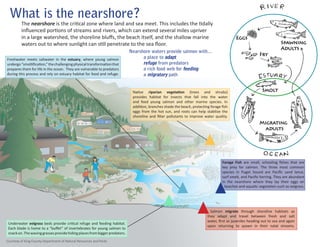
NSEA FINAL SalmonInTheNearshore brochure
- 1. What is the nearshore? Underwater eelgrass beds provide critical refuge and feeding habitat. Each blade is home to a “buffet” of invertebrates for young salmon to snackon.Thewavinggrassesprovidehidingplacesfrombiggerpredators. Forage Fish are small, schooling fishes that are key prey for salmon. The three most common species in Puget Sound are Pacific sand lance, surf smelt, and Pacific herring. They are abundant in the nearshore where they lay their eggs on Native riparian vegetation (trees and shrubs) provides habitat for insects that fall into the water and feed young salmon and other marine species. In addition, branches shade the beach, protecting forage fish eggs from the hot sun, and roots can help stabilize the shoreline and filter pollutants to improve water quality. The nearshore is the critical zone where land and sea meet. This includes the tidally influenced portions of streams and rivers, which can extend several miles upriver in a large watershed, the shoreline bluffs, the beach itself, and the shallow marine waters out to where sunlight can still penetrate to the sea floor. Salmon migrate through shoreline habitats as they adapt and travel between fresh and salt water, first as juveniles heading out to sea and again upon returning to spawn in their natal streams. Courtesy of King County Department of Natural Resources and Parks Eggs Fry Spawning Adults Smolt Migrating adults Nearshore waters provide salmon with... a place to adapt refuge from predators a rich food web for feeding a migratory path beaches and aquatic vegetation such as eelgrass. Freshwater meets saltwater in the estuary, where young salmon undergo“smoltification,”thechallengingphysicaltransformationthat prepares them for life in the ocean. They are vulnerable to predators during this process and rely on estuary habitat for food and refuge.
- 2. Salmon in the Be an active citizen, learn more, and get involved! l l l l Additional Resources: Brochure produced by the Nooksack Salmon Enhancment Association. Funded in part through the Whatcom Assistance Program, administered by WRIA 1 Joint Board and Salmon Recovery Board with funding provided by EPA for advancing the Puget Sound Action Agenda. The information presented may not necessarily reflect the views of the WRIA 1 Boards or its member entities. wria1project.whatcomcounty.org mrc.whatcomcounty.org Nearshore What Can YOU do to Save Salmon & Shorelines? Salmon.wria1.org www.n-sea.org Be a steward of native riparian vegetation! Keep or install a buffer of native plants along the beach or bluff. Shoreline armoring such as bulkheads and seawalls negatively impact forage fish spawning habitat. Consider stabilizing shorelines with native vegetation or soft shore armoring where possible. Marine and freshwater water quality is impaired throughout Puget Sound. Keep pollutants from going into the Sound and consider using environmentally friendly products in your home and yard. Eelgrass is sensitive to disturbance - avoid trampling it on the beach and anchoring in eelgrass beds while boating. Printed on 100% recycled materials - please do your part